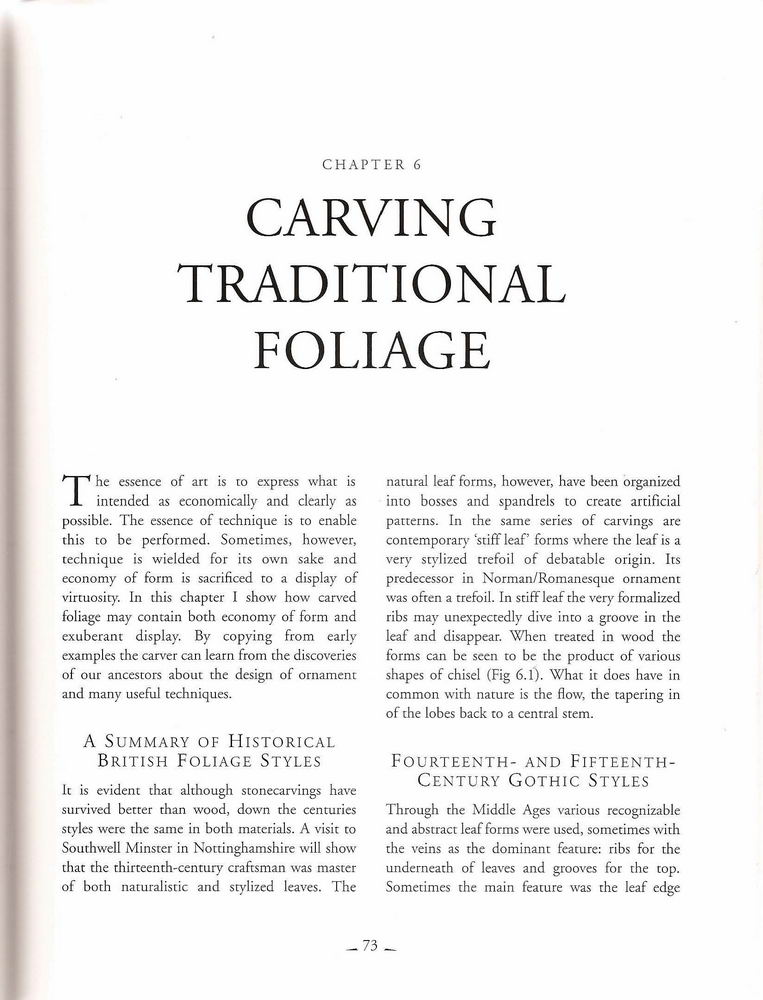essentÊrving°73

CHAPTER6
CARVING
TRADITIONAL
FOLIAGE
The essence of art is to express what is intended as economically and clearly as possible. The essence of technique is to enable this to be performed. Somecimes, however, technique is wielded for its own sake and economy of form is sacrificed co a display of virtuosity. In this chapter I show how carved foliagc may contain both economy of form and exuberant display. By copying from early examples the carver can learn from che discoveries of our ancestors about the design of ornament and many useful techniques.
A SUMMARY OF HlSTORICAL British Foliage Styles
It is evident that although sconccarvings have survived better than wood, down the centurics styles wcrc the same in both matcrials. A vi$it to Southwell Minster in Nottinghamshire will show that the thirteenth-century craftsman was master of both naturalistic and stylized leaves. The natural leaf forms, however, have been organized into bosses and spandrcls to create artificial patterns. In the same series of carvings are contemporary stifflcaf’ forms where the leaf is a very stylized trefoil of debatable origin. Its predecessor in Norman/Romancsque ornament was often a trefoil. In stiff leaf the vcry formalized ribs may unexpeccedly dive into a groove in the leaf and disappear. When treated in wood the forms can be scen to be the product of various shapes of chisel (Fig 6.1). What it does have in common with naturę is the flow, the tapering in of the lobes back to a central stem.
Fourteenth- AND Fifteenth-Century Gothic Styles
Through the iMiddle Ages various recognizable and abstract leaf forms were used, somecimes with the veins as the dominant feature: ribs for the underneach of leaves and grooves for the top. Someiimes che main feature was che leaf edge
-73 -
Wyszukiwarka
Podobne podstrony:
Distributed Circuit theory The first of these is known as distributed Circuit theory (which is one s
The story of the reaction of Sulekhas peers to her interest in girls’ activities (e.g., dancing and
system 10 10 who eagerly took the opportunity of learning how to breathe deeply during quick body-mo
essent?rving?14 ESSENTIAL WOODCARNING TECHNIQUES 1 Base flattened before beginning carving. downward
essent?rving?20 Essen tial Woodcarving T e c h n i q u e sChoosing the BestDlRECTION OF THE GRAIN Th
21 21 e n t Why project 1.3 Project management for PhDs The essence of project management is to work
Technique of Taxation The essence of the Institute’s proposal reduces to this. The growth of product
chapter. However, sińce technical problems are mostly partial, the subordination of social Sciences
18.3 million NOK is the cost of the all the essential GMS network eÄ…uipment for the cities of Stavan
CHAPTER I 10 86230 at the moment of their adoption, for their possible di8trlbutive effects; (d)
kryzys bułgarski (4) IW CHAPTER9 urn for our futurc than cithcr the rdationship of tlie Porte to its
MATCHING OF TRANSMISSION LINES In this chapter we will continue the development of transmission linÄ™
essent?rving?71 F O L I A G E : COPYING A NATURAL L E A F IN W O O D ignore. The carver of this oak
essent?rving?87 L I N F. N F O I. D Fig 7.13 Cutting along the top of the lower fołd.COLOUR AND FlNI
essent?rving?11 C A R V I N G A Bo V L Taking Inspiration from THE SHAPE OF THE WOOD Sometimcs a bur
essent?rving?35 Fic 12.17 NotÄ™ the fullness of the brom and tbe eyebalis and the slope np from cheek
więcej podobnych podstron